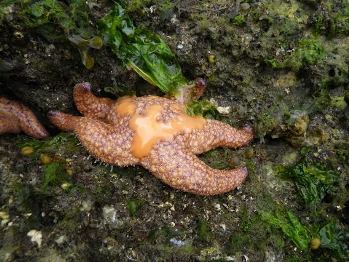— by Russel Barsh, Kwiáht and the Indian Island Marine Health Observatory —
Wasting away?
Northwest newspapers caused waves this fall with reports of “huge numbers” of starfish being “ravaged” and “turned into goo” by a “mysterious disease” that “baffles scientists” and could result in the “extinction” of West Coast sea stars. Our monitoring stations on Lopez, Orcas, and San Juan Islands have not yet encountered a single affected animal. Are we just lucky, or are press reports of a starfish disaster overblown?
Wasting syndrome was first described on the West Coast in 1978. Outbreaks
were observed again in 1983 and 1997, with the most severe impacts in California. The current episode extends from Anchorage to Los Angeles, but its prevalence varies greatly between locations. Most affected sites are in central and southern California.
Within the Salish Sea, large numbers of wasting starfish have only been re
ported from Croker Island near Vancouver, B.C. Affected individuals have also been reported from two sites in the south Sound, and Cattle Point in the San Juan Islands.
“Wasting” describes symptoms that may have multiple causes. Like leprosy in
humans, onset appears as a discolored patch of the ectoderm or skin of the starfish. As time passes, the tissue around the discolored patch dies. This may result in the loss of an arm, for example, or any number of additional opportunistic infections that eventually kill the weakened animal, often within days.
Vibrio bacteria isolated from affected West Coast and Mediterranean starfish are at least one of the causes of wasting symptoms. Species of
Vibrio also cause cholera and a wide variety of diseases of aquatic organisms. Like many other bacteria, Vibrio are more active in warmer water. Warmer conditions promote the spread of starfish wasting syndrome experimentally, and most large-scale outbreaks of wasting syndrome coincide
with cyclical ocean warming events such as El Niño.
Ochre stars (Pisaster ochraceus) are especially susceptible to contagious disease because they are gregarious and aggregate in very large numbers, like humans. Cyclical diseases are common in ecosystems (and human societies). Survivors of each cycle have acquired immunity, and eventually regenerate a population dense enough to promote the outbreak of the next strain that the pathogen evolves.
While dramatic, cyclical outbreaks represent a dynamic balance of host immunity and pathogen evolution.
Photographs posted on the Internet purporting to show “wasting” starfish include animals with injuries from predation, and stranded animals that have dessicated. Media accounts have also confused wasting syndrome with mass strandings of starfish, which are poorly understood but more likely to be caused by storm surges than disease. Over the last few years, mass stranding made headlines in Lincolnshire, U.K. (January 2013); the west coast of Ireland (November 2012); the Carolinas (April 2011, February 2012); Wales (March 2011); and Santa Barbara, California (March 2010).
**If you are reading theOrcasonian for free, thank your fellow islanders. If you would like to support theOrcasonian CLICK HERE to set your modestly-priced, voluntary subscription. Otherwise, no worries; we’re happy to share with you.**









Thanks for the good info, Russel. Anyone wanting to “adopt” one of these prolific and fascinating Ochre Stars, should contact Russel rbarsh@gmail.
Thanks Margot! The Indian Island Marine Health Observatory is giving folks the opportunity to “adopt” some of the significant species at Indian Island, including the Ochre star. For more information e-mail Russel at kwiaht@gmail.com or Kelly Rose at exploreindianisland@gmail.com.